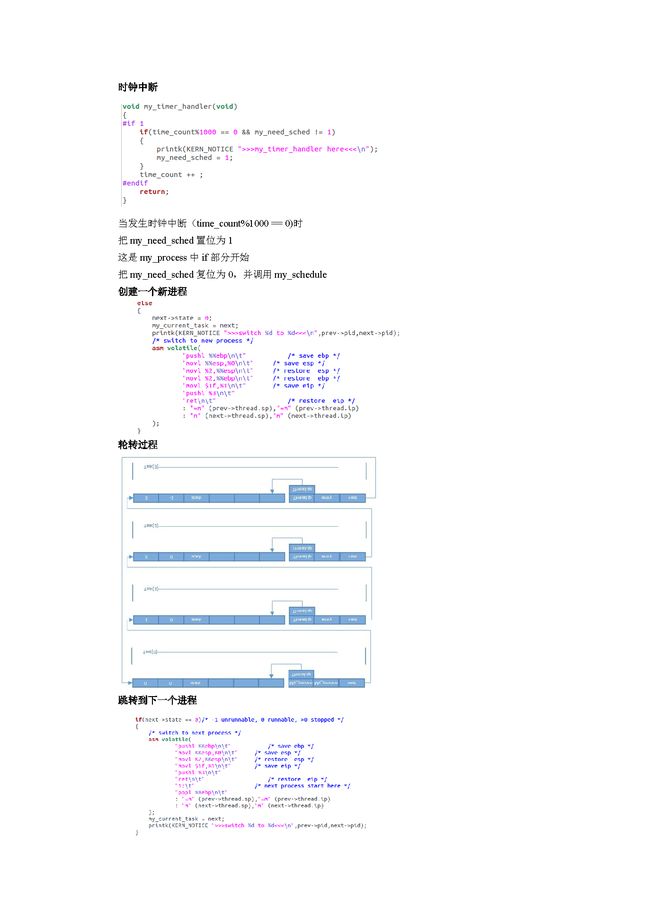韩岩___第2课___《linux内核分析》MOOC课
题目:简单的时间片轮转多道程序内核代码
一、简单的时钟中断程序
1、代码mymain.c
#include
#include
#include
#include
#include
#include
#include
#include
#include
#include
#include
#include
#include
#include
#include
#include
#include
#include
#include
#include
#include
#include
#include
#include
#include
#include
#include
#include
#include
#include
#include
#include
#include
#include
#include
#include
#include
#include
#include
#include
#include
#include
#include
#include
#include
#include
#include
#include
#include
#include
#include
#include
#include
#include
#include
#include
#include
#include
#include
#include
#include
#include
#include
#include
#include
#include
#include
#include
#ifdefCONFIG_X86_LOCAL_APIC
#include
#endif
void__init my_start_kernel(void)
{
int i = 0;
while(1)
{
i++;
if(i%10000000 == 0)
printk(KERN_NOTICE"my_start_kernel here %d\n",i);
}
}
2、myinterupt.c程序代码如下:
#include
#include
#include
#include
#include
#include
#include
#include
#include
#include
#include
#include
#include
#include
#include
#include
#include
#include
#include
#include
#include
#include
#include
#include
#include
#include
#include
#defineCREATE_TRACE_POINTS
#include
/*
* Called by timer interrupt.
*/
voidmy_timer_handler(void)
{
printk(KERN_NOTICE"\n>>>>>my_timer_handler here<<<<<\n\n");
}
3、运行结果:
二、简单的时间片轮转多道程序
1、mypcb.h
#defineMAX_TASK_NUM 4
#defineKERNEL_STACK_SIZE 1024*8
/*CPU-specific state of this task */
structThread {
unsigned long ip;
unsigned long sp;
};
typedefstruct PCB{
int pid;
volatile long state; /* -1 unrunnable, 0 runnable, >0 stopped */
char stack[KERNEL_STACK_SIZE];
/* CPU-specific state of this task */
struct Thread thread;
unsigned long task_entry;
struct PCB *next;
}tPCB;
voidmy_schedule(void);
以上程序的结构为:
结构体包括:
Ø 1个pid位
Ø 1个state位
Ø 1个堆栈
Ø 1个线程(包括ip、sp)
Ø 1个入口与1个next位
2、mymain.c
#include
#include
#include
#include
#include
#include"mypcb.h"
tPCBtask[MAX_TASK_NUM];
tPCB *my_current_task = NULL;
volatileint my_need_sched = 0;
voidmy_process(void);
void__init my_start_kernel(void)
{
int pid = 0;
int i;
/* Initialize process 0*/
task[pid].pid = pid;
task[pid].state = 0;/* -1 unrunnable, 0runnable, >0 stopped */
task[pid].task_entry = task[pid].thread.ip= (unsigned long)my_process;
task[pid].thread.sp = (unsignedlong)&task[pid].stack[KERNEL_STACK_SIZE-1];
task[pid].next = &task[pid];
/*fork more process */
for(i=1;i { memcpy(&task[i],&task[0],sizeof(tPCB)); task[i].pid = i; task[i].state = -1; task[i].thread.sp = (unsignedlong)&task[i].stack[KERNEL_STACK_SIZE-1]; task[i].next = task[i-1].next; task[i-1].next = &task[i]; } /* start process 0 by task[0] */ pid = 0; my_current_task = &task[pid]; asm volatile( "movl%1,%%esp\n\t" /* settask[pid].thread.sp to esp */ "pushl%1\n\t" /* push ebp */ "pushl%0\n\t" /* push task[pid].thread.ip */ "ret\n\t" /* pop task[pid].thread.ip to eip*/ "popl%%ebp\n\t" : :"c" (task[pid].thread.ip),"d" (task[pid].thread.sp) /* input c or d mean %ecx/%edx*/ ); } voidmy_process(void) { int i = 0; while(1) { i++; if(i%10000000 == 0) { printk(KERN_NOTICE "this isprocess %d -\n",my_current_task->pid); if(my_need_sched == 1) { my_need_sched = 0; my_schedule(); } printk(KERN_NOTICE"this is process %d +\n",my_current_task->pid); } } } 3、myinterrupt.c #include #include #include #include #include #include"mypcb.h" externtPCB task[MAX_TASK_NUM]; externtPCB * my_current_task; externvolatile int my_need_sched; volatileint time_count = 0; /* * Called by timer interrupt. * it runs in the name of current runningprocess, * so it use kernel stack of current runningprocess */ voidmy_timer_handler(void) { #if 1 if(time_count%1000 == 0 &&my_need_sched != 1) { printk(KERN_NOTICE">>>my_timer_handler here<<<\n"); my_need_sched = 1; } time_count ++ ; #endif return; } voidmy_schedule(void) { tPCB * next; tPCB * prev; if(my_current_task == NULL || my_current_task->next == NULL) { return; } printk(KERN_NOTICE">>>my_schedule<<<\n"); /* schedule */ next = my_current_task->next; prev = my_current_task; if(next->state == 0)/* -1 unrunnable, 0runnable, >0 stopped */ { /*switch to next process */ asmvolatile( "pushl%%ebp\n\t" /* save ebp */ "movl%%esp,%0\n\t" /* save esp */ "movl%2,%%esp\n\t" /* restore esp */ "movl$1f,%1\n\t" /* save eip */ "pushl%3\n\t" "ret\n\t" /* restore eip */ "1:\t" /* next process start here */ "popl%%ebp\n\t" :"=m" (prev->thread.sp),"=m" (prev->thread.ip) :"m" (next->thread.sp),"m" (next->thread.ip) ); my_current_task= next; printk(KERN_NOTICE">>>switch %d to%d<<<\n",prev->pid,next->pid); } else { next->state = 0; my_current_task = next; printk(KERN_NOTICE">>>switch %d to%d<<<\n",prev->pid,next->pid); /*switch to new process */ asmvolatile( "pushl%%ebp\n\t" /* save ebp */ "movl%%esp,%0\n\t" /* save esp */ "movl%2,%%esp\n\t" /* restore esp */ "movl%2,%%ebp\n\t" /* restore ebp */ "movl$1f,%1\n\t" /* save eip */ "pushl%3\n\t" "ret\n\t" /* restore eip */ :"=m" (prev->thread.sp),"=m" (prev->thread.ip) :"m" (next->thread.sp),"m" (next->thread.ip) ); } return; } 4、编译以上代码: gcc–c 文件名.c 生成目标文件后 cdLinuxKernel/linux-3.9.4 qemu-kernel arch/x86/boot/bzImage





